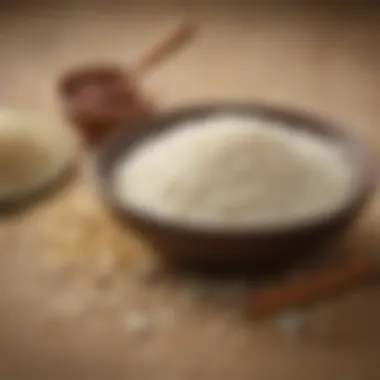Can You Eat Rice on Passover? Exploring the Debate


Intro
Passover, a significant festival in the Jewish calendar, is marked by numerous dietary laws that govern what can and cannot be consumed. These laws derive from ancient texts and traditions, creating complexity and variation in practices among different Jewish communities. One of the often-debated topics during this time is the permissibility of rice. This food, a staple in many diets worldwide, raises questions due to its association with kitniyot, a category that includes beans, corn, and rice.
As we delve deeper into this subject, it is vital to understand the historical context of these laws, cultural implications, and varying interpretations that influence whether rice is considered acceptable during Passover. Food enthusiasts and observant individuals alike will benefit from a thorough exploration of the nuances surrounding this staple grain.
Understanding Passover Dietary Laws
The dietary laws associated with Passover are central to the observance of this significant Jewish holiday. Understanding these laws can provide deeper insight into the religious and cultural practices that shape the celebration. This section lays the groundwork for an exploration of what is permitted and what is forbidden during Passover, particularly concerning rice.
Overview of Passover
Passover, known in Hebrew as Pesach, commemorates the Exodus of the Israelites from slavery in Egypt. It is celebrated for eight days, starting on the 15th of Nisan. The story of Passover is primarily told through the Haggadah, which outlines the historical events and rituals observed during the Seder meal. The themes of freedom and redemption are at the forefront of this celebration.
During this time, observant Jews follow strict dietary restrictions that highlight the importance of maintaining a distinction between permitted and forbidden foods. This is where the concept of chametz comes into play, leading to various interpretations of what constitutes acceptable consumption during the holiday.
Historical Context of Dietary Restrictions
The dietary restrictions observed during Passover are deeply rooted in Jewish history and tradition. The origins of these laws can be traced back to the Torah, where specific instructions regarding food were outlined. The Exodus story emphasizes the urgency of the Israelites' departure, which is why bread was made without leaven (yeast). This necessity leads to further elaborations of dietary laws over centuries, guiding Jewish communities in their observance.
The rabbis of later generations further expanded on these texts, incorporating additional customs and interpretations. Notably, the 11th-century Jewish scholar Rashi and others provided crucial commentaries that shaped modern understandings. The development of these practices illustrates how the passage of time influenced Jewish attitudes toward food and observance.
The Concept of Chametz
Chametz is a critical concept during Passover. It refers to any leavened food made from five grains: wheat, barley, oats, rye, and spelt. The prohibition against chametz is strictly enforced, leading to a complete search and removal from the home before Passover begins. The significance of avoiding chametz is both historical and spiritual, symbolizing the departure from slavery to freedom.
In a modern context, avoiding chametz has led to various interpretations, sparking debate about what other grains or foods may be permissible. While many Jews adhere to the traditional view of chametz, others examine the definitions and classifications of various food items, such as rice. Understanding chametz is key to navigating the dietary landscape of Passover and discussing the place of rice within these laws.
Key Note: The laws concerning chametz serve as a reminder of the complex relationship between food, identity, and religious observance, shaping how communities engage with their heritage.
Rice as a Grain: Analyzing the Classification
Understanding the classification of rice is essential when discussing its consumability during Passover. Rice holds a complex place in Jewish dietary laws, with various interpretations leading to divergent opinions among different communities. By dissecting the botanical and culinary definitions of rice, along with its representation in Jewish texts, we can better grasp why this grain invokes such significant debate. This knowledge not only enriches our understanding of rice but also informs our practice during this culturally and historically rich holiday.
Botanical vs. Culinary Definitions
The distinction between botanical and culinary definitions of rice is crucial in assessing its classification. Botanically, rice belongs to the family of grasses called Poaceae. This family encompasses a wide range of grains, including wheat, barley, and oats. Culinary definitions, however, consider rice a grain primarily used for cooking and consumption. This dual classification leads to confusion regarding its dietary status during Passover.
In culinary contexts, rice acts differently than other grains deemed chametz, such as wheat and barley. The preparation and consumption of rice do not involve fermentation, a critical factor when it comes to chametz. This aspect often leads people to perceive rice as a valid substitute or accompaniment to traditional Passover foods. Nonetheless, some stricter interpretations equate all grains with potential for fermentation as problematic during the holiday.
It is worth noting the specific types of rice, such as long-grain, short-grain, and sticky rice. Each type has distinct characteristics that influence its role in Passover meals. Thus, understanding these differences is vital when discussing dietary choices for the holiday.
Rice in Jewish Texts
Various Jewish texts address the permissibility of rice during Passover. Key religious documents include the Torah and later rabbinic writings. These texts often reflect historical practices and shifts in opinions regarding dietary laws. The Talmud, for instance, provides insights that shape contemporary understanding and practice concerning rice.


Interestingly, rice is mentioned in the context of being an acceptable food choice in some interpretations. For instance, the Sephardic tradition generally sees rice as permissible, referring to texts that support this view. In contrast, the Ashkenazi tradition typically forbids rice, partly due to concerns over its potential cross-contamination with chametz grains.
Moreover, rabbinical discourse on rice often references its preparation methods. The clarification about whether rice should be treated like chametz or as a permitted food source impacts how communities segregate their food during Passover. The ongoing debates reflect the adaptability and openness of Jewish law to various cultural influences.
The classifications and discussions surrounding rice serve as a reminder of the complexity of Jewish dietary laws. Understanding the nuances found in botanical versus culinary definitions, alongside historical texts, provides a clearer perspective for individuals navigating food choices during Passover.
Cultural Perspectives on Eating Rice
Cultural perspectives play a crucial role in determining the dietary practices of any community, and rice consumption during Passover is no exception. Various Jewish customs and regional practices have shaped how rice is viewed across different Jewish cultures. These perspectives not only reflect historical evolution but also address contemporary dietary choices. Understanding these cultural intricacies helps food enthusiasts and observants navigate the complexities surrounding rice consumption during this significant holiday.
Ashkenazi Views on Rice
For Ashkenazi Jews, rice has traditionally been prohibited during Passover. This prohibition stems from historical conventions that originated in medieval Europe. Many Ashkenazi observers consider rice to be kitniyot, which encompasses legumes and certain grains that undergo similar processing to wheat. The rationale for avoiding kitniyot includes concerns regarding potential mixing with actual chametz, or leavened bread products. Therefore, Ashkenazi communities often find themselves selecting alternative starchy foods like matzah or potatoes, which have been widely accepted within their dietary frameworks.
Despite this broad prohibition, some modern Ashkenazi families have begun to reconsider these restrictions. They might incorporate rice on Passover as part of a personal or family adaptation. However, such changes are still contentious and vary from one individual to another.
Sephardi Practices Regarding Rice
In contrast to Ashkenazi customs, Sephardi Jews generally permit rice consumption during Passover. Many Sephardi communities view rice as a staple food and a vital part of their holiday meal planning. These groups see rice as an integral component of culinary traditions, often by preparing dishes like rice pilafs or rice with vegetables during the Passover festivities.
This differing attitude toward rice reflects broader cultural differences. In many Mediterranean and Middle Eastern countries, rice is a common food source and is readily available. Rather than viewing it as a potential source of chametz, Sephardi traditions embrace its versatility and flavor. Therefore, for those following Sephardi customs, rice's place on the Passover table holds less controversy and more significance.
Modern Adaptations and Observances
As global travel and intercultural exchange have risen, many Jewish families now navigate a blend of both Ashkenazi and Sephardi practices regarding rice. Modern adaptations often reflect personal preferences and community influences. In certain communities, there may be an increasing acceptance of rice, driven by younger generations who seek to reconcile traditional practices with contemporary dietary needs.
Observances during Passover continue to evolve, reflecting the intersection of ancient laws with modern living. Below are some responses or modifications individuals may consider:
- Personal Preferences: Families may choose to adopt rice in various forms, depending on personal beliefs about kosher laws.
- Creative Recipe Development: New recipes incorporating rice emerge as people explore innovative ways to celebrate.
- Community Discourse: Discussions within communities often lead to shifts in long-standing practices as members challenge and adapt tradition.
"The evolution of rice consumption during Passover demonstrates how cultural perspectives shape dietary laws, leading to varied observances within the Jewish community."
This diverse landscape makes it important for each individual or family to weigh their traditions while considering their community norms. These cultural perspectives provide a rich understanding of how rice fits—or does not fit—within Passover practices.
Permissible Types of Rice
Understanding the classification of rice as permissible during Passover is essential for those observing this sacred time. The distinction between unprocessed and processed rice holds not only culinary significance but also a deeper connection to adherence and interpretation of Jewish law. This section provides a structured look into two main categories: unprocessed rice and processed rice, along with considerations needed during preparation.
Unprocessed vs. Processed Rice
Unprocessed rice, including varieties such as basmati, jasmine, and short-grain rice, is typically considered ground zero for dietary compliance. The critical factor here is the absence of additives or modifications that could complicate its status during Passover. When rice is harvested, it generally requires minimal handling aside from cleaning and packaging. This simplicity makes unprocessed rice a safer choice for those adhering strictly to Kosher laws.
on the other hand, processed rice may include products such as rice flour, rice cakes, and seasoned rice mixes. These versions often contain additional ingredients that might jeopardize their Kosher status during Passover. The challenge lies in ensuring that these products do not contain chametz or any derivatives from wheat, barley, rye, oats, or spelt, which are forbidden during this festival. Food enthusiasts should navigate with caution and scrutinize labels to ascertain compliance.
Considerations for Rice Preparation


Preparing rice during Passover involves several essential considerations that go beyond merely cooking the grains. Here are a few important points to keep in mind:
- Choice of Rice: Opt for certified Kosher rice specifically labeled for Passover to eliminate doubts regarding ingredients and processes. Check for reliable certification marks that attest to its purity.
- Washing and Soaking: Rinsing unprocessed rice before cooking is recommended. This step can potentially remove dust particles or contaminants from handling, further ensuring dietary adherence. Some may also soak the rice, depending on their personal practice.
- Cooking Utensils: Ensure that pots, pans, and utensils used for rice preparation were not used with chametz before Passover. Use newly designated or thoroughly cleaned items to mitigate any risk of cross-contamination.
- Timing and Environment: During the Passover seders, maintaining a controlled environment is crucial. In cases where rice is prepared in shared kitchen space, consider using separate cooking areas or times to avoid unintentional mixing with non-Kosher items.
"The adherence to dietary laws during Passover is not simply about food but a reflection of tradition and faith."
By being aware of these factors, individuals can confidently incorporate rice into their Passover meals while respecting the historical and cultural significance of this dietary practice.
What Do Authorities Say?
Understanding the perspectives of authoritative figures within the Jewish community is essential when discussing dietary practices during Passover, particularly regarding the consumption of rice. This section sheds light on the views of rabbis and scholars, as well as responses from various Jewish organizations. Their insights provide a framework for people navigating dietary decisions during this important holiday.
Rabbis and Scholars’ Perspectives
The stance of rabbis on rice consumption during Passover is diverse, reflecting a spectrum of interpretation within Jewish law. Some rabbis vehemently oppose the consumption of rice, citing traditional prohibitions held by Ashkenazi communities. Others, especially within Sephardi traditions, embrace rice as a permissible option.
Rabbis who oppose rice argue that it can resemble wheat products, leading to potential confusion about chametz, the leavened bread restricted during Passover. They stress the importance of strict adherence to traditions passed down through generations, emphasizing that Jewish law is not to be taken lightly.
On the other side, some scholars advocate for a more modern perspective. They acknowledge that rice, being a non-chametz grain, can be consumed safely during Passover, particularly if prepared thoughtfully. They contend that the needs and practices of contemporary Jewish life should inform dietary decisions. These differing views highlight the complexity of the topic, urging individuals to consider their community's customs, personal beliefs, and the advice of their spiritual leaders.
Responses from Jewish Organizations
Jewish organizations also play an influential role in shaping opinions about dietary practices on Passover. Groups like Chabad and the Orthodox Union often provide guidelines and community resources regarding what is considered kosher for Passover.
- Chabad encourages individuals to follow local customs and seek guidance from their rabbinic authority regarding the inclusion of rice in their Passover meals.
- The Orthodox Union states that while rice is not a traditional food for Ashkenazi Jews, Sephardi communities have historically had a different approach, allowing its consumption. This organization’s rulings serve as guidelines for many when determining what is appropriate to eat during the holiday.
Community responses can vary widely, reflecting a diversity of practices among Jewish population. Engagement with local congregations often leads to a better understanding of what is considered acceptable.
"Passover provides an opportunity for self-reflection and communal engagement. The dietary choices made during this time can bridge tradition and modernity."
Practical Implications for Observance
Understanding the practical implications of observing Passover dietary laws is crucial for those who want to ensure their celebrations are both meaningful and compliant. This section discusses essential aspects such as meal planning and recipe development that respect the traditions and restrictions of this significant time in the Jewish calendar. Thoroughly considering these implications helps maintain the integrity of the holiday while allowing individuals to enjoy their meals.
Meal Planning for Passover
When planning meals for Passover, careful consideration must be given to what is considered kosher for the holiday. Rice consumption, widely accepted in some Jewish communities, is often a point of contention. Some individuals find themselves perplexed about how to integrate rice into their meal plans while being faithful to their traditions. Here are some practical steps to follow:
- Know Your Dietary Restrictions: Familiarize yourself with the specific customs of your community, whether Ashkenazi or Sephardi, as they significantly influence what grains may be consumed.
- Choose Quality Ingredients: Select high-quality, preferably organic rice. This can help in preparing dishes that not only align with dietary laws but also taste great.
- Plan Balanced Meals: Incorporate a variety of fresh vegetables, proteins, and other allowable foods alongside rice to ensure that meals are both nourishing and satisfying.
- Consider Family Traditions: Each family may have its unique customs and recipes for Passover. Integrate traditional elements, possibly combined with rice, to maintain a connection to the past.
Effective meal planning can alleviate stress during the holiday and enable a more reflective observance of Passover.
Recipes Incorporating Rice
For those who decide to include rice in their Passover meals, numerous recipes can enhance the celebration. The versatility of rice allows for a range of dishes, from side items to main courses. Here are a few examples:


- Rice Pilaf with Dried Fruits: Combining rice with sautéed onions, nuts, and dried fruits can create a delightful side dish that adds a layer of richness to any meal.
- Stuffed Peppers with Rice: Using rice as a base, stuff bell peppers with a mix of vegetables and spices, then bake. This dish not only looks appealing but is also fully compliant with holiday requirements.
- Rice Salad with Herbs: A refreshing salad made with cooled rice, fresh herbs, olive oil, and lemon juice can serve as a light accompaniment. This dish can balance heavier meals and invigorate the palate.
"Integrating rice into Passover meals involves both honoring tradition and adapting to modern culinary preferences."
By exploring various rice-based recipes, individuals can elevate their Passover dining experience while remaining mindful of the essential observances associated with the holiday.
Personal Choices and Community Practices
Understanding personal choices and community practices regarding dietary observances during Passover is essential. This aspect reflects how individuals and groups navigate religious traditions in a modern context, particularly concerning rice consumption during the holiday. The flexibility and variation in practices reveal a rich tapestry of beliefs and adaptations within Jewish communities.
Individual Observance Variations
When we talk about individual observance, it’s crucial to recognize that each person's approach can differ significantly. Factors influencing these choices include cultural background, family traditions, and personal beliefs. Some people adhere strictly to traditional customs, while others adopt a more lenient stance, especially concerning rice.
For instance, Ashkenazi Jews often refrain from eating rice during Passover, viewing it as a potential violation of chametz laws. Conversely, many Sephardi Jews include rice in their Passover meals, considering it permissible. This divergence illustrates that individual choices can be very personal and complex, shaped by an interplay of communal practices and unique family histories.
Community Norms and Adaptations
Community norms also play a significant role in shaping dietary choices during Passover. Different communities often establish their own interpretations of what is acceptable. In some areas, there might be a strong tradition of banning legumes and rice, while in others, these foods are celebrated as integral to Passover feasts. This collective understanding develops over time, influenced by rabbinic guidelines and the prevailing cultural context.
Moreover, adaptive practices have emerged in response to contemporary needs. For example, some communities now embrace a variety of rice dishes because they recognize that many members have dietary restrictions or seek more diversity in their holiday meals. Such adaptations can also be seen through the incorporation of modern culinary techniques or ingredients into traditional recipes.
"The way a community approaches Passover dietary laws can deeply influence personal practices and vice versa."
Closure: Navigating Dietary Choices on Passover
The exploration of dietary choices during Passover is essential for both observant Jews and culinary enthusiasts. Understanding the complexities regarding the consumption of rice sheds light on broader dietary laws within Judaism. This topic highlights the intersection of tradition and contemporary practices, providing insight into how different Jewish communities interpret and apply these laws.
Dietary choices during Passover are not merely about food restrictions. They reflect cultural heritage, personal beliefs, and community norms. This article emphasizes the significance of rice in such discussions, acknowledging its role among various Jewish communities while providing a framework for understanding its permissibility.
When navigating these dietary choices, several considerations emerge. These include the diverse historical contexts that shape current practices and the varying opinions from religious authorities. Recognizing the nuances among Ashkenazi and Sephardi perspectives allows individuals to appreciate the diversity within Jewish customs and encourages a more informed observance.
Key elements to remember include the ongoing conversation surrounding rice consumption. As communities continue to engage with dietary laws, insights can lead to adaptations in practices.
"Dietary observance during Passover requires knowledge, reflection, and often a balancing act between tradition and individual choice."
Being informed helps individuals make personal choices aligned with their beliefs while respecting community norms. It also fosters an environment of understanding and adaptability.
Ultimately, navigating dietary choices on Passover broadens our understanding of Jewish identity, cultural practices, and modernity's role in religious observance. These elements work together to create a rich tapestry of experiences, making the study of Passover dietary laws relevant for both the faithful and the curious food lover.
Key Takeaways
- Understanding of Chametz: Knowing what constitutes chametz is essential for determining acceptable foods during Passover.
- Cultural Variations: Ashkenazi and Sephardi communities have different approaches to rice consumption, reflecting their unique traditions.
- Personal Choice: Individual adherence to dietary laws can vary, allowing for meaningful discussions on the nature of observance.
- Community Impact: Practices within communities influence personal decisions, creating a dynamic dialogue about tradition and adaptation.
- Ongoing Discourse: The conversation around food choices continues to evolve, highlighting the adaptability of dietary laws.
Future Directions for Research
Research on Passover dietary practices can take many forms. Future studies could focus on:
- Regional Differences: Examining how geography influences dietary laws and customs, especially concerning rice.
- Intergenerational Practices: Understanding how dietary choices are transmitted across generations and how they change.
- Culinary Innovations: Exploring modern recipes that incorporate traditional elements in novel ways, including rice dishes.
- Community Surveys: Gathering quantitative data on the prevalence of rice consumption in different Jewish communities across the world.
Further exploration in these areas will provide deeper insights into the relevance of dietary laws and their impact on cultural identity. This can support a greater understanding of how observant individuals and communities adapt to changing circumstances while maintaining their distinct traditions.







